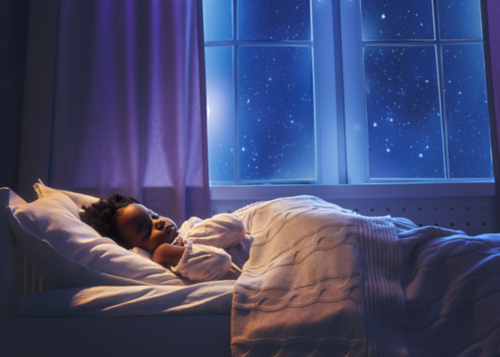St. Jude Family of Websites
Explore our cutting edge research, world-class patient care, career opportunities and more.
St. Jude Children's Research Hospital Home

- Fundraising
St. Jude Family of Websites
Explore our cutting edge research, world-class patient care, career opportunities and more.
St. Jude Children's Research Hospital Home

- Fundraising
Hydroxyurea may help kids with sickle cell disease breathe better at night

Artistic rendering of a child with sickle cell disease sleeping well at night. AI-assisted illustration created by Madison Rice.
Checking on a sleeping child is a habit for many parents. Ensuring they are safe and peacefully spending their night in deep slumber can be comforting. However, for parents of children with sickle cell disease, nights can be stressful. People with sickle cell disease have a higher risk of developing sleep-disordered breathing, resulting in conditions such as sleep apnea and dangerously low blood oxygen levels.
“Everyone has slightly lower blood oxygen levels at night,” said Jane Hankins, MD, MS, St. Jude Global Hematology Program director and Department of Global Medicine member. “But in sickle cell disease, red blood cells already can’t deliver oxygen efficiently. Even a small loss of blood oxygen in these children can cause problems, as they are starting at a lower threshold.”
Patients with sickle cell disease start at a lower oxygen level because its trademark mutation alters the oxygen-carrying molecule hemoglobin in red blood cells. Many symptoms of sickle cell disease originate from mutated hemoglobin’s inability to get enough oxygen to a particular tissue, including acute pain crises and organ dysfunction. However, the connection between sleep disruption and sickle cell disease has remained unclear.
“When I first learned that patients with sickle cell disease experience obstructive sleep apnea, it was very confusing to me,” said Zachary Abramson, MD, DMD, St. Jude Department of Radiology, a current radiology researcher and former dentist who studied sleep apnea. Abramson’s background is in oral and maxillofacial surgery, having treated children with craniofacial deformities and obese adults suffering from obstructive sleep apnea. “I was surprised to learn that children with sickle cell disease suffer the same disorder, despite not falling into either category. I was curious what might be going on in these patients.”
Hydroxyurea may decrease inflammation to improve nighttime breathing
Fortunately, hydroxyurea, the most common treatment for sickle cell disease, appears to decrease sleep-disordered breathing. With that information, Abramson and Hankins teamed up with several colleagues to find out why. Published in Pediatric Blood and Cancer, the collaborators took a first step in understanding the relationship between hydroxyurea, sickle cell disease and sleep.
“We found that patients who had more severe sickle cell disease had more severe sleep apnea and sleep disorders,” said Abramson, who served as the first and corresponding author. “But we also saw that hydroxyurea therapy was associated with improved breathing while sleeping and improved inflammatory markers.”
Sickle cell disease causes the immune system to flare up inappropriately. Sleep apnea responds to inflammation and is pro-inflammatory itself. While the study only showed associations, it is plausible that sickle cell disease and sleep apnea form a feedback loop, increasing inflammation and sleep disruption over time.
Hydroxyurea may interrupt that process.
“We think hydroxyurea decreases the inflammation in the body and helps improve sleep for children with sickle cell,” Hankins, senior author of the study, said. “Now we have a hypothesis that we want to test; this paper is just the beginning of defining that complex relationship.”
Providing a breath of fresh air to explain the benefits of hydroxyurea
While the scientists have only begun to identify the exact mechanism underlying how hydroxyurea may improve sleep-disordered breathing, their results support growing evidence that hydroxyurea treatment helps children sleep better. While not part of the study, improving sleep has positive benefits for children with sickle cell disease, while leaving sleep unaddressed can have negative consequences.
“Poor sleep is associated with decreased pain tolerance and lower neurocognitive performance for children with sickle cell disease, but we can help.” Abramson said. “Physicians need to know about the link between sickle cell disease and sleep-disordered breathing, test for it, and then appropriately prescribe hydroxyurea in addition to standard therapies for sleep-disordered breathing, which we saw was associated with better sleep. It could lead to these children living healthier, happier lives.”
However, misinformation has caused some patients and families to hesitate to take hydroxyurea. “It’s become more difficult over time to explain the benefits of this treatment as families often encounter a lot of incorrect information online,” Hankins, who has treated many children with sickle cell disease, said. “But this study gives us one more tool in the toolbox when discussing the benefits and risks of hydroxyurea with patients and families.”
As a final message, Hankins wants any parent checking in on their slumbering child with sickle cell disease today to know: “Hydroxyurea may help your child in many different ways, including help your child sleep better at night.”






